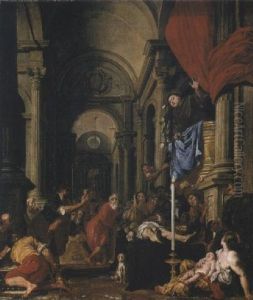Giovanni Francesco Carbone Paintings
Giovanni Francesco Carbone, known also as Gian Francesco Carbone, was an Italian painter of the Baroque period, born in 1615 in Genoa, Italy. His early life is relatively obscure, but it is known that he emerged from the Genoese school of painting, which was prominent in the 17th century. Carbone's artistic journey is often overshadowed by the more renowned figures of his time, such as his contemporary, Giovanni Benedetto Castiglione, who was also from Genoa. Nonetheless, Carbone made a modest contribution to the art world during his lifetime.
Carbone was primarily active in his hometown of Genoa. His style was influenced by the works of the great masters who preceded him, such as Bernardo Strozzi and Gioacchino Assereto, and also by the dramatic chiaroscuro and dynamic compositions of Caravaggio. Although he never gained the same level of fame as some of his contemporaries, Carbone's work was appreciated for its expressiveness and his ability to capture the emotional depth of religious subjects.
The majority of Carbone's works are religious in nature, reflecting the intense spirituality and the Counter-Reformation themes that were prevalent in Genoese art during this period. His paintings often featured saints and biblical figures, rendered with a heightened sense of drama and a focus on the human form. Carbone's brushwork was characterized by a certain looseness and vigor, which gave his paintings a lively, albeit sometimes rough, quality.
Unfortunately, many of Carbone's paintings have not survived, or their attributions have become uncertain over time. This has made it difficult for art historians to fully assess his oeuvre and its impact on the art world. What is known is that during his career, he was respected by his peers and received commissions from local religious institutions.
Carbone passed away in 1685, leaving behind a modest body of work that reflects the transition in Genoese painting from the exuberance of the high Baroque to the more subdued and introspective late Baroque period. While he may not have achieved widespread fame, Giovanni Francesco Carbone remains a figure of interest for those studying the nuances of Genoese Baroque art and the lesser-known artists who contributed to its development.
